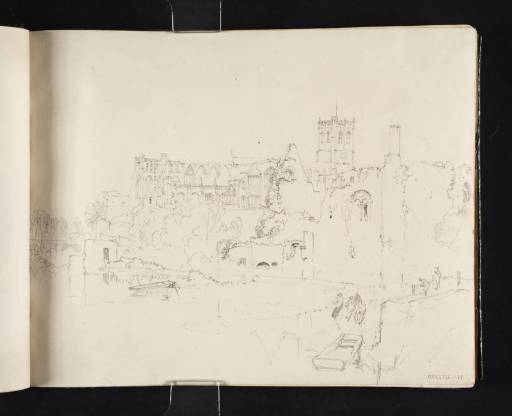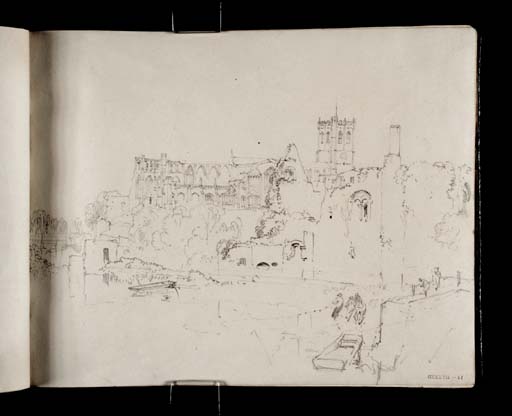Joseph Mallord William Turner Christchurch Priory and the Constable's House from the Avon Bridge ?1811
Image 1 of 2
Joseph Mallord William Turner,
Christchurch Priory and the Constable's House from the Avon Bridge
?1811
Joseph Mallord William Turner 1775–1851
Folio 5 Recto:
Christchurch Priory and the Constable’s House from the Avon Bridge ?1811
D10310
Turner Bequest CXXXVII 67
Turner Bequest CXXXVII 67
Pencil on white wove paper, 181 x 228 mm
Blind-stamped with Turner Bequest monogram bottom right
Stamped in black ‘CXXXVII 67’ bottom right
Blind-stamped with Turner Bequest monogram bottom right
Stamped in black ‘CXXXVII 67’ bottom right
Accepted by the nation as part of the Turner Bequest 1856
Exhibition history
1879
Oxford Loan Collection, University Galleries, Oxford, 1879 until at least 1909 (71; renumbered 62a, as ‘Abbey by river side’).
References
1904
E.T. Cook and Alexander Wedderburn eds., Library Edition: The Works of John Ruskin: Volume XIII: Turner: The Harbours of England; Catalogues and Notes, London 1904, p.563 (Oxford loans catalogue, 1878) no.62, as ‘Sedburgh (?) [sic] Abbey’.
1909
A.J. Finberg, A Complete Inventory of the Drawings of the Turner Bequest, London 1909, vol.I, p.396, CXXXVII 67, as ‘Christchurch, Hants.’.
1997
Howard J.M. Hanley and Paul M. Holland, ‘Turner’s Banknotes and the West Country Tour of 1811’, Turner Society News, no.76, August 1997, p.15.
Turner’s viewpoint is the bridge over the main eastern channel of the River Avon, looking south to medieval Christchurch Priory, now in Dorset but in western Hampshire in Turner’s time, past the Constable’s House, associated with Christchurch’s small castle, which is just out of sight to the right. Between the punt towards the left and the figures on the right is a sloping bank, beyond which a narrow subsidiary channel of the river runs immediately below the walls of the Constable’s House, where the reflections of some features are indicated. The building, including its prominent gable and chimney, remains in much the same state, as does the church.
There are other, slighter drawings of the priory and the coast to the south in the Devonshire Coast, No.1 sketchbook (see under Tate D08403; Turner Bequest CXXIII 22). As there are no other identified views of the town, it is probable that this, the only detailed drawing made there, dates from the same 1811 West Country tour undertaken to gather material for watercolours to be engraved for the Picturesque Views on the Southern Coast of England (see the Introduction to the 1811 tour).1 The subject was not developed for the series, but an unfinished watercolour known as Coast Scene with White Cliffs and Boats (Yale Center for British Art, New Haven, Connecticut),2 of a similar size to those Turner did complete, appears to show the view from Christchurch towards the Isle of Wight recorded in the Devonshire Coast, No.1 drawing mentioned above and in Tate D08411 (CXXIII 27). Views of Lulworth Cove on folios 22 recto and 23 recto (D10237, D10238; CXXXVII 21, 22) of the present book are also likely to have been made on the 1811 tour.
In the published catalogue of loans to Oxford University, John Ruskin misidentified the subject as ‘Sedburgh (?) Abbey’,3 presumably a typographical error for Jedburgh, of which there are views in the 1797 North of England sketchbook (including Tate D00972; Turner Bequest XXXIV 63) and in the later Abbotsford sketchbook (including Tate D26039; Turner Bequest CCLXVII 65a). The latter sketch was the basis a watercolour (Taft Museum of Art, Cincinnati, Ohio),4 engraved for Water Scott’s Poetical Works in 1834 (Tate impression: T04947); with its long nave, square tower and setting of water and trees there is a loose general resemblance to Turner’s study of Christchurch.
Verso:
Blank, save for inscription by John Ruskin in red ink ‘943’ bottom left.
Matthew Imms
May 2011
How to cite
Matthew Imms, ‘Christchurch Priory and the Constable’s House from the Avon Bridge ?1811 by Joseph Mallord William Turner’, catalogue entry, May 2011, in David Blayney Brown (ed.), J.M.W. Turner: Sketchbooks, Drawings and Watercolours, Tate Research Publication, December 2012, https://www


